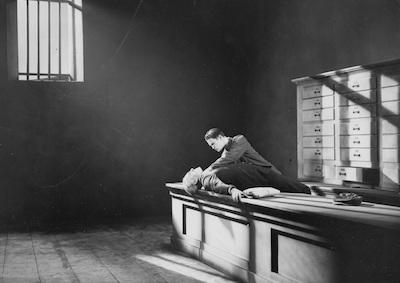Access every screening in the UCLA Festival of Preservation with a $50 pass.
Ben Pollack and His Park Central Orchestra (1929)
Preservation funding provided by The Antique Phonograph Society and Jon Sonneborne.
Bandleader Ben Pollack and his top jazz musicians trekked to the newly wired Brooklyn Vitaphone studios in July of 1929 to film this restored short. The band personnel was truly legendary, and featured Jack Teagarden on trombone and vocals, Jimmy McPartland on trumpet, Dick Morgan (later of the Spike Jones band) on guitar, and a just-turned 20-year-old on clarinet named Benny Goodman. The 16-inch Vitaphone disc for the sound portion turned up in Connecticut in February 2018 and was acquired by the Vitaphone Project.—Ron Hutchinson
35mm, b/w, 10 min. Production: Vitaphone. Distribution: Warner Brothers Pictures Inc.
Restored by UCLA Film & Television Archive in conjunction with The Antique Phonograph Society and The Vitaphone Project. Laboratory services by Fotokem, Audio Mechanics, DJ Audio, Inc. Special thanks to Warner Bros., the Library of Congress, John Levin, Ron Hutchinson.
Alibi (1929)
Preservation funding provided by The Film Foundation and The George Lucas Family Foundation.
In September 1928, two months after the debut of the first all-talkie feature, Lights of New York, rehearsal started on another gangster picture, United Artists’ maiden talkie, Alibi. Actor Regis Toomey remembered rehearsing “as though it were a stage show, we could have gone with it into any theater afterward.” Despite director Roland West’s long tenure in the theater, he was a visual stylist producing such illustrative silents as The Bat (1926) and The Dove (1928). His wedding of stagecraft, film and audio technique made Alibi a breakthrough. Film grammar was back—the moving camera, the close shot, editing—and nascent sound technique, not mere transcription, awakened an entirely new dimension in storytelling, creating rhythm and suspense.
Alibi has a distinct ambivalence in the doubling of its protagonists, a hardened criminal who perhaps has gone straight, and a cynical cop who works the margins of the law to prove otherwise. Nominated for three Academy Awards, Alibi was cheered by critics, planting the seeds for the year’s subsequent flowering of sound pictures like Bulldog Drummond and Applause.
Alibi has retained a tentative grasp on posterity. In the legal maw of Raymond Rohauer a single 35mm print was pulled from the compromised negative in the 1950s before being lodged with Henri Langlois on the promise of free storage. Rohauer got what he paid for; when he attempted to retrieve the negative in the 1960s it had apparently vanished in the legendary 1959 Cinémathèque Française fire. A hasty 16mm dupe negative from the 1950s print left Alibi looking and sounding like something the cat dragged in, the 35mm master print abandoned to Rohauer’s European distributor as a circulation print. Rescued by David Meeker for the BFI, that unique copy has been complemented by UCLA’s audio discs and digital technology. Alibi is now full length and looking better than it has since 1929.—Scott MacQueen
DCP, b/w, 90 min. Production: Feature Productions. Distribution: United Artists. Presented by Joseph M. Schenck. Producer: Roland West. Director: Roland West. Based on the play Nightstick by John Griffith Wray, J.C. Nugent, Elaine S. Carrington. Screenwriter: Roland West, C. Gardner Sullivan. Cinematographer: Ray June. Production Designer: William Cameron Menzies. Editor: Hal Kern. Cast: Chester Morris, Harry Stubbs, Eleanor Griffith, Regis Toomey, Mae Busch.
Restored by UCLA Film & Television Archive in conjunction with The Film Foundation in collaboration with Cohen Film Collection. Laboratory services by Image Protection Services LLC, Roundabout Entertainment, Audio Mechanics, DJ Audio, Inc. Special thanks to David Meeker, British Film Institute, Sean Coughlin, Wisconsin Center for Film and Theater Research, Megan Boyd, Fotokem, New York State Archives.






 Mobile Navigation
Mobile Navigation

